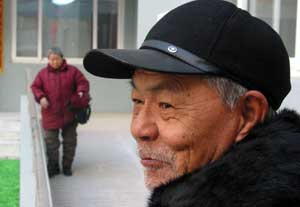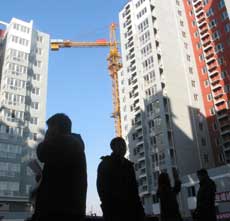|
Low-rent scheme boon for urban poor
(China Daily)
Updated: 2004-02-19 00:48
Drawing on the success of providing low-rent accommodation for poor urban households in cities such as Beijing and Shanghai, the central government has come up with a policy to extend the benefit nationwide.
For years, Zhao Wenlan has been thinking of buying a washing machine.

Zhang Cheng, 78, and his wife Zhao Wenlan, 61, stand outside the low-rent building they have just moved into last week. The city's per capita living space in about 10,000 poverty-stricken households has risen from 2.2 square metres in 2001 to 10.7 square metres by the end of last year. [newsphoto] |
But her previous home, a 25-square-metre house in Beijing's Fengtai District, shared by five --including her husband, their son, daughter-in-law and grandson -- barely had room for the gadget.
Last week, Zhao, who moved in with her husband into a new 40-square-metre apartment, said she is now seriously considering the purchase.
"I can buy a washing machine now because there is enough space," says Zhao.
Zhao and her husband, Zhang Zheng, are among the recent beneficiaries of the municipal government's low-rent housing policy.
A batch of 400 low-income families have got the nod to move into the low-rent building, located near the East Second Ring Road -- not far from plush buildings that house high-income earners and business people and top hotels. Thirty apartments are specially designed for the disabled.
Low-rent housing scheme
About 10,000 households have so far benefited from the low-rent housing scheme started in 2001 by the Beijing government.
According to the scheme, about 140,000 urban residents in Beijing who are living on the government's minimum living allowance are eligible to apply for the low-rent houses. Meanwhile, poor and disabled veterans and families of those who died for the country or at their posts are also covered by the programme.
The Beijing municipal government announced last week that per capita living space in about 10,000 poverty-stricken households had risen from 2.2 square metres in 2001 to 10.7 square metres by the end of last year, thanks to the housing policy.
Zhang, 78, was eligible for the house because of his bravery during the Korean War (1950-53). He lost both feet in the battle.
Even though their apartment is on the 13th floor, the war veteran and his wife, who is also handicapped in her feet from childhood, feel no inconvenience.

About 10,000 households have so far benefited from the low-rent housing scheme started in 2001 by the Beijing government. [newsphoto] |
"We are satisfied that we can live decently as we are getting old," says the man. "We never thought of living in a building with elevators, flush toilet and washing room."
The monthly rent per square metre for the new apartment is about 2.5 yuan (30 US cents) and Zhang pays 100 yuan (US$12) a month. "I can afford it," says Zhang, whose pension is about 1,000 yuan (US$120) per month. Just a few metres away from the 16-storey low-rent building stands a commercial residential building, which sells for 7,000 yuan (US$840) per square metre.
To the couple's further delight, their grandson, who is attending junior school, can now have his own room to study in their old home back in Fengtai.
Drawing upon the experience of Beijing, Shanghai and other pioneering cities, the central government recently made public a regulation on low-rent house management, which is scheduled to take effect on March 1.
In the regulation, the government vows to provide low-rent shelter nationwide for the urban poor, who live in low-quality homes with no tap water or toilet facilities.
"We aim to help the poor people in urban areas," says Xie Jiajin, director of the Real Estate Department of the Ministry of Construction.
Regulation
The regulation says that low-rent housing would be available to every poor urban household which receives the local minimum living allowance; and whose per capita living space is less than 60 per cent of the local average.
After the adoption of the programme nationwide, the low-rent-housing scheme will become part of China's social security system, together with the medical insurance, pension insurance and the minimum living allowance.
The central government began to reform the urban housing system in the mid-1980s. Houses were no longer allocated free to employees by their working units. Instead, market prices are applied to most houses, even though some middle- and low-income families could buy designated houses at cheaper prices. The living space is thus mostly decided by each family's income level.
As China continues on the fast track of economic development, the income gap among Chinese urbanites continues to widen.
The National Bureau of Statistics (NBS) recently announced that per capita income of top earners, who account for 20 per cent of the urban population, posted a year-on-year increase of 12.4 per cent to reach 13,120 yuan (US$1,590) during previous January-September period.
In contrast, per capita income of low-income urban residents, who also make up 20 per cent of urbanites, edged up by 8.3 per cent year-on-year to 2,433 yuan (US$295) in the same period.
But home prices in cities are largely beyond residents' purchasing power, especially low-income earners.
In Beijing, only about 10 per cent of the housing sells for less than 4,000 yuan (US$480) per square metre. In Shanghai, only 18 per cent of the apartments are priced below 3,500 yuan (US$421.6) per square metre and in East China's Hangzhou, only 3.7 per cent are available for below 3,000 yuan (US$360) per square metre.
In underdeveloped western regions, per capita living space is usually less than the national average.
Official survey
The latest official survey shows that per-capita floor space in 21 major cities in the west is only 17 square metres. Poor families in cities in this part of the country, 4 per cent of urban residents, dwell in old or unsafe places, such as clay shelters or old buildings without kitchens and toilets, or simple plank cabins.
"The scheme to accommodate poor residents in low-rent apartments benefits the most needy in the city," says Director Xie.
But still more money is needed for the projects that are geared to making more people live more comfortably.
"Despite the regulations in place, we still face an uphill task to achieve the goal," says Xie.
|